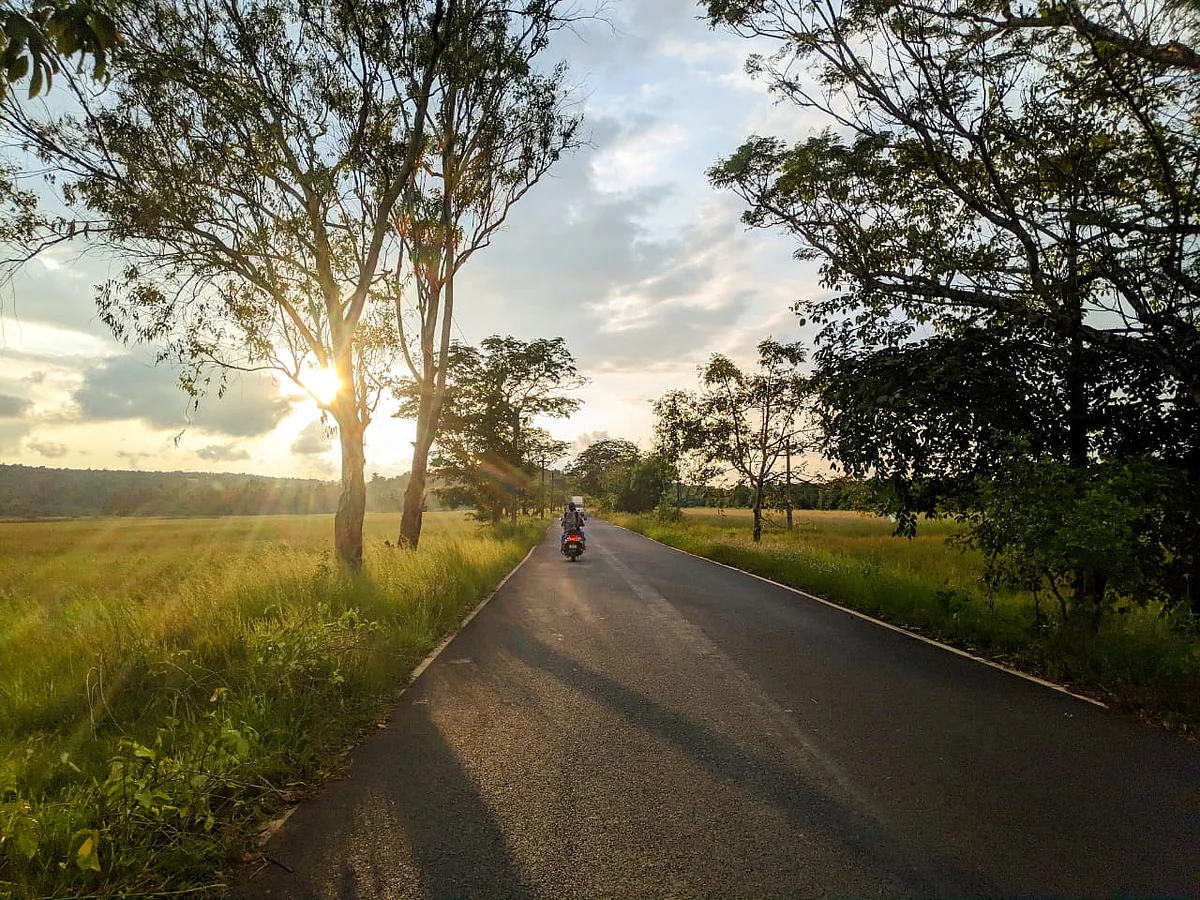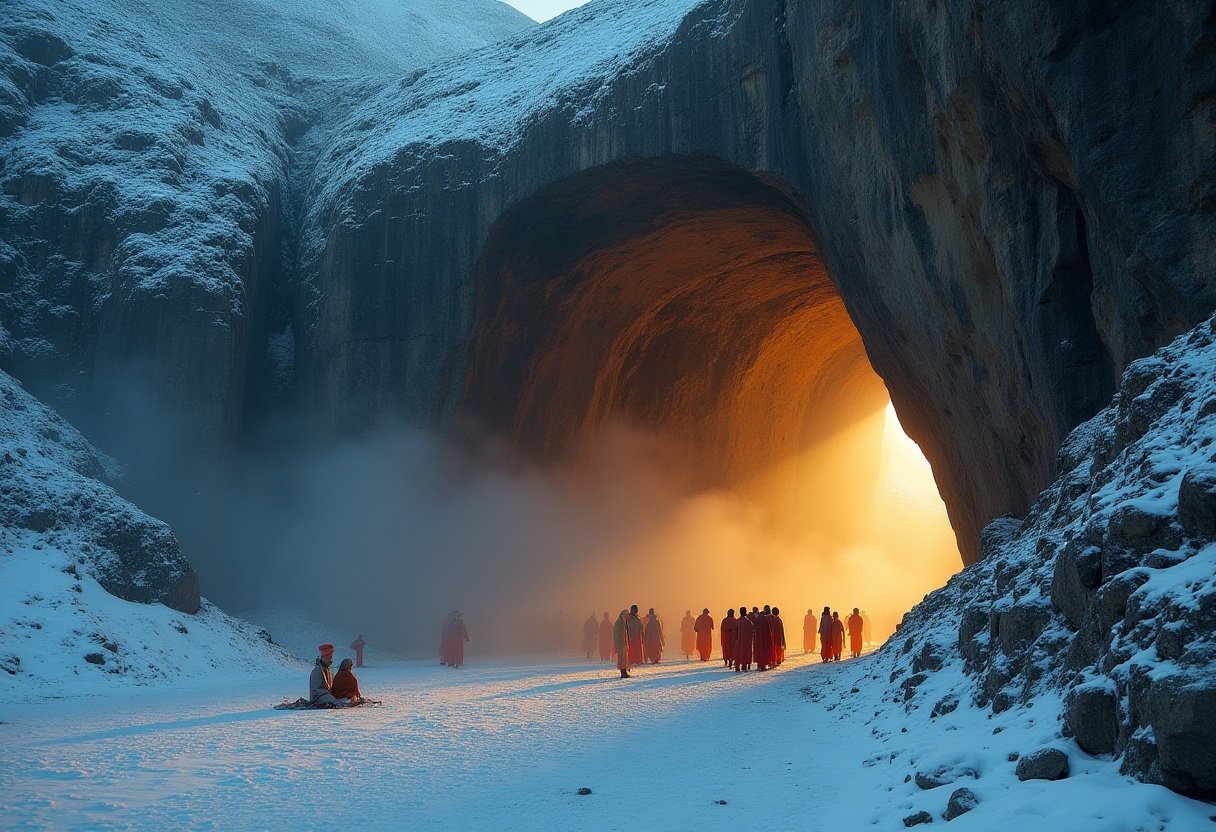Spiritual Travel
7 ways to seek spiritual awakening in Goa|Gomantak Times

WELLNESS WAYS
There is no dearth of wellness centres offering treatments and therapies to balance mind, body and spirit. These range from Ayurvedic massages, detoxification programs, and holistic healing practices for spiritual well-being.
Spiritual places in Goa|Goa spiritual discovery|Best places for peace in Goa|Spiritual sites Goa|Goa meditation spots
Spiritual Travel
Chhattisgarh CM Sai showers flowers on Kanwariyas from chopper; unveils Rs146cr Bhoramdeo spiritual tourism plan | Raipur News

RAIPUR: Chhattisgarh chief minister Vishnu Deo Sai on Monday organized a flower shower from a helicopter over thousands of Kanwariyas (Shiva devotees) marching in Kabirdham district as part of the third Monday of the holy Sawan month. Speaking to the media at the airstrip, CM Sai said that the govt is developing ‘Bhoramdeo corridor’ with a budget of Rs 146 crore which will have special facilities for pilgrims.
We are also in talks with the Madhya Pradesh govt to provide land in Amarkantak for setting up rest houses for Kanwariyas, CM said.Chief Minister along with deputy chief ministers Vijay Sharma, Arun Sao, and assembly speaker Dr. Raman Singh, took part in the spiritual celebration.Each year, Kanwariyas undertake a 100-km foot march from Amarkantak in MP to Bhoramdeo in Chhattisgarh, to offer sacred water at the historic temple. The govt organized a grand welcome, with local MLA Bhawna Bohra leading arrangements at Kabirdham.Across the region, saffron-clad men and women filled the streets, singing devotional songs and waving tricolour Kanwars.Chief Minister Sai said, “Rs 146 crore spiritual tourism project under the Swadesh Darshan 2.0 scheme will be developed as ‘Bhoramdeo Corridor’, aimed at transforming the iconic 11th-century temple into a holistic religious destination.”The announcement coincided with a grand floral shower by helicopter over Kanwar pilgrims at Bhoramdeo.Speaking to the media, CM Sai said the project would not only revamp the historic Bhoramdeo Temple complex but also integrate other spiritually significant sites, including Madwa Mahal, Cherki Mahal, Ramchua, and Saroda Reservoir, creating a seamless spiritual and heritage circuit.Located in Choura village, 18 km from Kawardha, the Bhoramdeo Temple is a sacred 11th-century archaeological marvel where Lord Shiva is worshipped as Baba Bhoramdeo.Thousands of pilgrims from Kabirdham, Mungeli, Bemetara, Khairagarh, Rajnandgaon, and even Amarkantak in Madhya Pradesh are participating this year as they undertake this journey barefoot, wearing saffron clothes, trekking up to 150 kilometers through rocky forest paths, reaffirming their faith with each step.To facilitate the 151-kilometer Kanwar Yatra, Deputy Chief Minister and Home Minister Vijay Sharma said that medical teams and police patrols have been deployed across key routes, including Kawardha-Bemetara Highway, Bhoramdeo Road, and forest stretches near Pandariya and Kukdoor.
Spiritual Travel
Haridwar’s tragedy: Safety is non-negotiable for India’s spiritual tourism economy
The stampede at Haridwar’s Mansa Devi Temple in late July, which claimed several lives and left scores injured, has once again exposed the chronic vulnerabilities of India’s pilgrimage tourism sector. The accident, triggered by panic during the height of the Shravan pilgrimage season, was a grim reminder that India’s religious economy one of the largest drivers of domestic tourism is built on a fragile foundation.
The pattern is disturbingly familiar. Major stampedes at temples and festivals have punctuated India’s recent history from the Vaishno Devi shrine in Jammu & Kashmir in 2022, to last year’s Hathras tragedy in Uttar Pradesh, which left 121 people dead. Most share common failings: overcrowded infrastructure, inadequate crowd control and a lack of emergency planning. Haridwar was no exception.
Since 2021, Haridwar has welcomed over 12.72 million tourists every year, according to official tourism data. That footfall translates into livelihoods for thousands. But the Mansa Devi tragedy now casts a shadow. As news spreads through viral videos, headlines, and anxious WhatsApp messages, there’s a real fear that prospective pilgrims will stay away, especially during peak periods like Shravan and Kumbh.
Pilgrimage tourism is big business. Haridwar alone attracts millions of visitors annually, underpinning a local economy of hotels, transport operators, food vendors and small traders. Nationally, religious tourism contributes billions of dollars to India’s GDP. But this economic engine relies heavily on public confidence. A single incident of this scale can deter pilgrims for months, and in some cases years, disrupting livelihoods that depend on steady visitor flows, dip in arrivals could translate into substantial revenue losses for hotels, transportation operators, small traders, and other ancillary businesses. The ramifications extend beyond short-term disruptions.
From crisis management to long-term safety planning
What makes this systemic neglect even more troubling is that solutions are neither complex nor out of reach. Technology-driven crowd management real-time monitoring, timed entry systems, and direct digital communication with pilgrims can dramatically reduce risk. Upgrading infrastructure to withstand peak footfalls, training security personnel, and enforcing stricter controls on gatherings are equally vital. Yet, investment in safety is too often treated as discretionary rather than as the non-negotiable foundation for sustaining tourism.
The consequences ripple far beyond the immediate tragedy. For local businesses, reduced pilgrim traffic can be financially crippling, especially for small enterprises that survive on narrow margins. For state governments, reputational damage translates directly into economic loss. And for India’s broader tourism economy, each incident erodes the country’s credibility as a safe and reliable destination.
Haridwar’s tragedy is not just a local failure; it is a national wake-up call
If India wishes to continue reaping the economic dividends of its vast religious tourism sector, safety must be treated as the bedrock, not the afterthought. Without systemic reforms spanning infrastructure, governance, and public accountability the next stampede may be only a festival season away.
The warning signs have been unmistakable. In 2025 alone, India has endured a string of devastating crowd disasters. The stampede at Haridwar’s Mansa Devi Temple was preceded by tragedy in Prayagraj, where, on January 29 during the Maha Kumbh Mela, at least 30 pilgrims were killed and over 60 injured. Just weeks later, on February 15, a deadly crush at New Delhi railway station claimed 18 lives as pilgrims made their way to the same festival. In Goa, at the Sri Lairai Devi Temple on May 3, a fire-walking ritual ended in panic, leaving six people dead.
Nor have these disasters been confined to religious gatherings. On June 4, a crowd surge during an IPL victory celebration at Bengaluru’s Chinnaswamy Stadium resulted in 11 fatalities. And then, Haridwar: a rumour of a loose electric wire on the temple stairway triggered panic that left multiple pilgrims dead and dozens injured within minutes.
These are not isolated events. They are systemic warnings. And they can no longer be ignored.
In places like Haridwar, the time for cosmetic fixes has long passed. Safety cannot be a last-minute checklist item; it must be woven into the very design and management of large gatherings. That means embracing digital ticketing and monitoring systems that pre-empt overcrowding. It requires wider walkways, clearly marked emergency exits, and round-the-clock medical facilities. Most importantly, it calls for empowering local authorities district officials, temple boards, and festival committees with the budgets, tools, and autonomy to act proactively rather than reactively.
Equally critical is visibility. When pilgrims and visitors see safety measures in action, it builds trust. And trust is what brings them back.
Cushioning the economic blow
Behind every news alert and statistic lies another quiet story, the kind that rarely makes headlines. A hotel with empty rooms. A food stall that used to sell out by noon is now barely making enough. A young boy who left school to help his parents recover their losses.
In pilgrimage towns, businesses often live season to season. A single tragedy can send shockwaves through these fragile economies. For many, there’s no safety net. The government must respond not just with statements of sympathy, but with real, tangible support. Emergency financial aid. Temporary GST relief. Easy-to-access loans for small traders and vendors trying to stay afloat.
But long-term recovery also means thinking differently. Haridwar has so much more to offer than just seasonal pilgrimages. With its natural beauty, deep-rooted traditions, and spiritual energy, it could become a centre for wellness, yoga, cultural exploration, and Ayurvedic healing. A more diversified tourism strategy could help smooth out seasonal spikes and create a more stable economic future.
A model for safer, sustainable pilgrimage
India is home to more than 300 major pilgrimage sites. In 2024, over 60 crore religious visits were recorded across the country. These numbers speak to the soul of a nation, but they also come with serious logistical responsibility.
Haridwar now has a chance to lead the way. To show the rest of India what it means to marry devotion with design, tradition with safety, and faith with planning. It can become more than a pilgrimage destination. It can become a national example of what safe, sustainable spiritual tourism looks like. That means investing in smart infrastructure. Creating safer spaces. Training emergency teams. Planning not just for celebration, but for the unexpected incidences. And making sure that every person, from a first-time visitor to a local resident, feels protected.
The stampede at Mansa Devi Temple is more than a moment of mourning it marks a critical inflection point. Haridwar now can recede into silence, or it can rise with purpose, transforming tragedy into a legacy of protection for generations to come.
In a country where faith is woven into daily life and pilgrimages sustain entire local economies, safety must not be an afterthought it must be part of the sacred pact between state, society, and the devotee. Every pilgrim sets out in hope, and that hope fuels hotels, transport operators, small traders, and a billion dollar religious tourism economy. When safety fails, it is not just lives that are lost; livelihoods crumble, businesses suffer, and destinations struggle to regain trust.
If India aspires to be a global leader in spiritual tourism, it must first lead in safety. Because no one seeking blessings should ever have to worry about returning home and no local economy should have to rebuild itself in the shadow of preventable tragedy.
Because in the end, safety is sacred too…
Disclaimer: The views expressed in this article are those of the author/authors and do not necessarily reflect the views of ET Edge Insights, its management, or its members
Spiritual Travel
How the Sacred Amarnath Yatra Drives Tourism Growth, Economic Revival, and Cultural Exchange Across Jammu & Kashmir

Sunday, July 27, 2025
The Amarnath Yatra, an annual pilgrimage to the sacred Amarnath Cave nestled deep within the Himalayas, serves as a powerful force that drives not only spiritual devotion but also a significant economic and cultural revival for Jammu & Kashmir. Each year, thousands of Hindu devotees make the arduous journey to seek the blessings of Baba Barfani. But beyond the spiritual significance, the Yatra’s economic and tourism impact is undeniable. This sacred trail from Pahalgam to the Amarnath Cave offers more than just an opportunity for pilgrims to renew their faith; it provides a substantial boost to local businesses, infrastructure, and tourist destinations around the region. With its blend of religious tourism and natural beauty, the Amarnath Yatra is transforming Jammu and Kashmir into a hub for both spiritual and leisure travel. In this report, we will delve into the multifaceted influence of the Yatra on the region’s economy, local tourism, and cultural exchange, while also discussing the challenges it faces, such as sustainability and safety concerns.
Economic Boost Through Pilgrimage Tourism: Amarnath Yatra’s Role in Jammu & Kashmir
The Amarnath Yatra is more than just a religious event; it’s a cornerstone of Jammu & Kashmir’s tourism and economy. Every year, between June and July, over three lakh pilgrims embark on this spiritual journey, creating a ripple effect that impacts local businesses, hospitality, and even the handicrafts industry. According to Ravi Gosain, President of the Indian Association of Tour Operators (IATO), the Yatra provides a “life-giving soul” to the region’s economy. It offers a much-needed influx of revenue to the local population and businesses, particularly in towns like Pahalgam and Baltal, which experience an extended peak tourist season as a direct result of the pilgrimage.
Key Economic Impacts of the Amarnath Yatra:
- Hotel and Hospitality Industry Surge: Hotels, guesthouses, and homestays in Pahalgam, Baltal, and other surrounding areas often report a surge in bookings, leading to a thriving hospitality business.
- Local Handicrafts and Vendors: Local artisans and vendors benefit significantly from the pilgrimage as they cater to thousands of pilgrims by selling traditional Kashmiri handicrafts, clothing, and food items.
- Extended Tourism Season: Pilgrims who participate in the Yatra often take time to explore nearby destinations like Srinagar, Gulmarg, and Sonmarg. This extends the tourism season beyond the typical summer months, ensuring a longer period of economic growth for the region.
Sustainable Tourism and Infrastructure Development: Challenges and Opportunities
While the economic benefits of the Yatra are substantial, there are challenges that accompany the influx of tourists. One of the primary concerns remains sustainability, particularly in terms of environmental impact and waste management. The Amarnath Cave, located at an altitude of over 3,800 meters, is vulnerable to environmental degradation. The massive foot traffic associated with the Yatra can lead to waste accumulation, soil erosion, and damage to the fragile ecosystem of the region.
Key Environmental Challenges:
- Waste Management: With over three lakh pilgrims passing through the region, waste disposal has become a major issue. Efforts are being made by local authorities to manage the growing amount of waste, but the lack of proper infrastructure remains a hurdle.
- Ecological Balance: The trek to the Amarnath Cave passes through protected forest areas. Unsustainable practices, such as deforestation and improper handling of waste, threaten the natural beauty of the area.
- Climate Change Effects: The changing climate patterns affect the accessibility of the Yatra route, with snowfall and rainfall potentially delaying the pilgrimage or causing hazards for pilgrims.
Despite these concerns, local authorities have begun to implement eco-friendly measures to mitigate the environmental impact. This includes initiatives such as setting up biodegradable waste disposal systems, encouraging pilgrims to reduce plastic usage, and enhancing awareness about preserving the region’s natural beauty.
Infrastructural Development Boost: The Yatra’s Long-Term Benefits
The Amarnath Yatra has catalyzed significant infrastructural development in Jammu & Kashmir. Improvements in road networks, healthcare facilities, and communication systems benefit both pilgrims and the local community. According to Mr. Gosain, these developments have far-reaching benefits, extending well beyond the Yatra itself. Better road access, especially to remote areas like Baltal, ensures smoother travel for pilgrims and boosts tourism year-round. Enhanced healthcare services ensure the safety of pilgrims, particularly those who embark on the challenging trek at high altitudes.
Infrastructural Gains:
- Road Connectivity: Significant upgrades to the road networks, particularly in areas like Baltal and Pahalgam, have enhanced connectivity, making travel easier for both pilgrims and tourists.
- Healthcare Facilities: The Yatra has led to better healthcare infrastructure, including the establishment of emergency medical camps along the trek. This infrastructure ensures the well-being of pilgrims, especially those requiring immediate medical attention during the journey.
- Mobile and Internet Connectivity: Improved telecommunications, particularly in remote areas, allow pilgrims to stay connected and access emergency services when needed.
Pilgrimage and Leisure: The Fusion of Faith and Tourism
One of the most exciting developments of the Amarnath Yatra’s impact is the fusion of pilgrimage tourism with leisure travel. While the Yatra primarily attracts religious tourists, many pilgrims extend their stay in the region to explore its stunning landscapes and picturesque towns. Gulmarg, Sonmarg, and Srinagar are some of the most sought-after leisure destinations for those completing the Yatra. The combination of spiritual significance and natural beauty has led to the growth of faith-based tourism in the region.
This blend of spirituality and leisure tourism has given birth to a new class of tourists who seek both an enriching religious experience and a relaxing holiday. As a result, destinations like Gulmarg, famous for its ski resorts, and Sonmarg, known for its scenic trekking routes, have seen increased tourist traffic during and after the pilgrimage.
Security Measures and Challenges
Despite the benefits, the Amarnath Yatra is not without its challenges. The security of pilgrims remains a top priority due to the sometimes volatile situation in Jammu & Kashmir. The threat of militant activities has necessitated the deployment of thousands of security personnel to ensure the safety of pilgrims during the Yatra.
Key Security Measures:
- High Security: Over 50,000 security personnel are deployed to ensure the safety of the pilgrims, especially in the wake of the recent events in Pahalgam.
- Emergency Response Teams: Trained emergency response teams are stationed along the route to manage unforeseen situations, such as natural calamities or health emergencies.
The Indian Army and paramilitary forces collaborate to maintain a safe environment, both for the pilgrims and the residents of Jammu & Kashmir. These efforts, while costly, are critical in maintaining the Yatra’s integrity and ensuring that the pilgrimage continues without disruptions.
Conclusion: The Amarnath Yatra as a Model of Faith-Based Tourism
The Amarnath Yatra represents a powerful example of how faith-based travel can intertwine with tourism to benefit an entire region economically, socially, and culturally. Through the Yatra, Jammu & Kashmir has not only established itself as a significant religious destination but has also enhanced its profile as a tourist hub with a strong emphasis on sustainability and community development. The fusion of spiritual devotion with leisure tourism offers a model for other destinations looking to balance cultural heritage with modern tourism demands. While challenges such as environmental sustainability and security continue to persist, the economic benefits and the infrastructure improvements stemming from the Yatra have brought long-term positive change to Jammu & Kashmir. It is clear that the Amarnath Yatra is not just a religious pilgrimage but a driving force in transforming the region’s tourism landscape, benefiting both pilgrims and the local economy alike.
Key Takeaways:
- The Amarnath Yatra drives tourism in Jammu & Kashmir, benefiting local businesses and extending the tourist season.
- Infrastructure improvements such as better roads and healthcare facilities benefit both pilgrims and local communities.
- The fusion of spiritual and leisure tourism in Kashmir creates a unique destination for travelers.
- Environmental and security challenges must be managed to ensure the Yatra’s continued success and sustainability.
-

 Brand Stories1 week ago
Brand Stories1 week agoBloom Hotels: A Modern Vision of Hospitality Redefining Travel
-

 Brand Stories2 days ago
Brand Stories2 days agoCheQin.ai sets a new standard for hotel booking with its AI capabilities: empowering travellers to bargain, choose the best, and book with clarity.
-

 Destinations & Things To Do1 week ago
Destinations & Things To Do1 week agoUntouched Destinations: Stunning Hidden Gems You Must Visit
-

 AI in Travel1 week ago
AI in Travel1 week agoAI Travel Revolution: Must-Have Guide to the Best Experience
-

 Brand Stories3 weeks ago
Brand Stories3 weeks agoVoice AI Startup ElevenLabs Plans to Add Hubs Around the World
-

 Brand Stories2 weeks ago
Brand Stories2 weeks agoHow Elon Musk’s rogue Grok chatbot became a cautionary AI tale
-

 Destinations & Things To Do2 days ago
Destinations & Things To Do2 days agoThis Hidden Beach in India Glows at Night-But Only in One Secret Season
-

 Asia Travel Pulse3 weeks ago
Asia Travel Pulse3 weeks agoLooking For Adventure In Asia? Here Are 7 Epic Destinations You Need To Experience At Least Once – Zee News
-

 AI in Travel3 weeks ago
AI in Travel3 weeks ago‘Will AI take my job?’ A trip to a Beijing fortune-telling bar to see what lies ahead | China
-

 Brand Stories3 weeks ago
Brand Stories3 weeks agoChatGPT — the last of the great romantics












